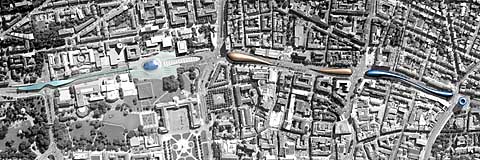|
|
|
Projects underway and a vision for the future
text by : Frank Heinlein, Werner Sobek
|
 Urban Design Study B14, Stuttgart
�
| ||
|
�Urban Design Study B14, Stuttgart
"B14" is the proposed redevelopment project for the surrounding areas of Highway B14 that runs through the center of Stuttgart.
The construction over the B14 of seven buildings debouching into landscaped gardens and art areas represents a new interpretation of the urban space as part of the dialog with the existing environment. Tubes, i.e. load-bearing lattice structures made up from annular elements, form the primary structural elements of the buildings. The façades consist of adaptive envelopes made of glass, metal, plastics or textile fabrics. These envelopes are capable of adapting their physical properties to environmental changes e.g. new materials can automatically change their thermal conductivity and the light transmission of glass panels can be controlled. |
Surpassing Archi-neering
"Dematerialization" and "materiality" are keywords when considering our projects over the last decade. In cooperation with our partners all over the world, Werner Sobek Ingenieure has constantly striven (and continues to do so) to achieve a new understanding of building through the synthesis of architecture and engineering, a concept often called "archi-neering". Our aim is to overcome the purely physical level, i.e. the question of how to optimize the use of material and other resources such as energy and space. This question is very important and it should in no way be neglected. But we want to consider also the metaphysical aspects, viz. the relationship between function, structure and appearance. These three factors should harmonize with each other, the one resulting naturally from the other. When considering the future development of architecture and engineering, there is no need to focus on exotic materials or technologies available only to a chosen few. It is more than sufficient to seriously ask ourselves how we want to live and work in the future, without hindering ourselves by looking back on how things have been done 10, 50 or 100 years ago. Simply by being open to influences from other sectors that are not directly linked to engineering and architecture opens up a plethora of new possibilities. Our task is to find solutions to the problems and needs of the present, with an unwavering eye on the future. This can only be reached by an open-mindedness that, we hope, has become apparent through the presentation of a wide variety of our projects in the present volume.
| |
|
LINKS In English
| ||
 |
|||||